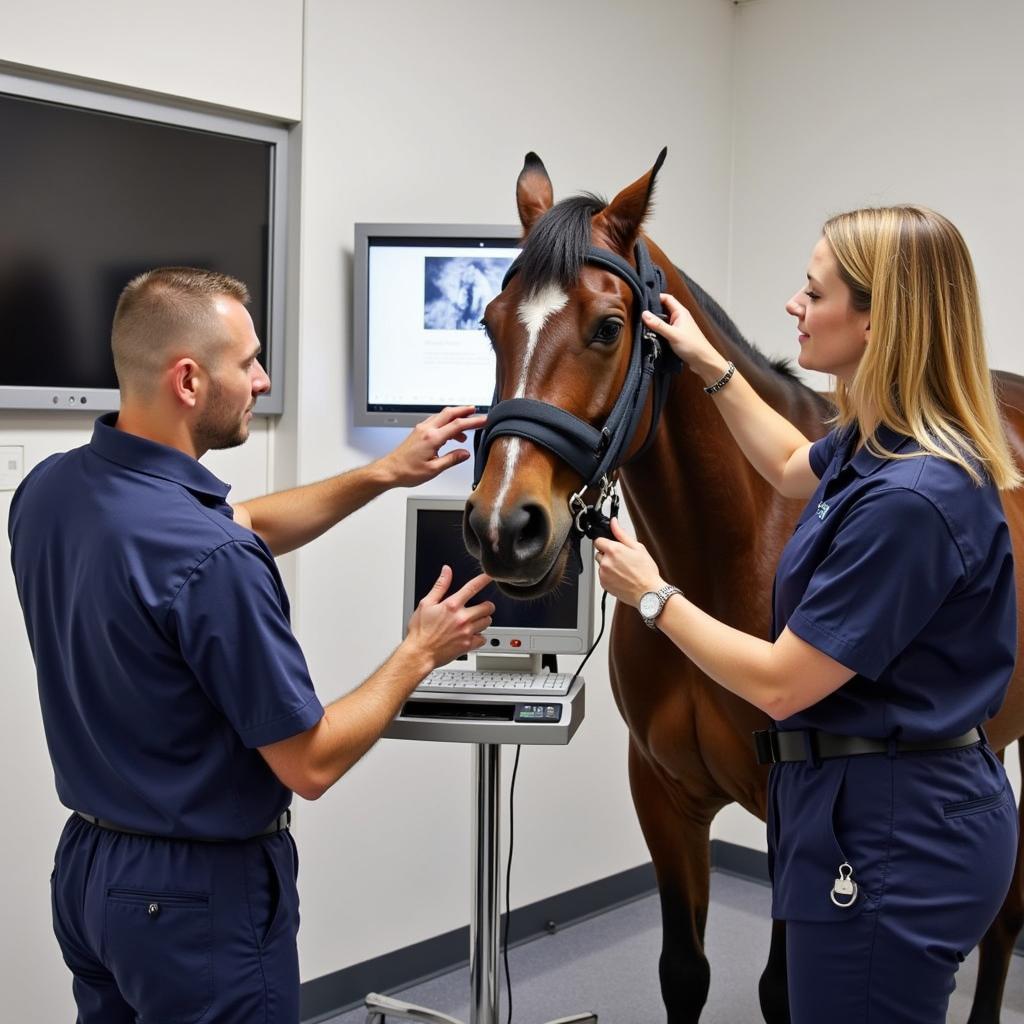Equine Horse Head Radiographs are essential diagnostic tools for veterinarians, providing a window into the complex structures within a horse’s head. These images help identify a range of conditions, from fractures and sinus infections to dental problems and temporomandibular joint (TMJ) disorders. Understanding the basics of equine head radiography can help horse owners better comprehend their horse’s health and the importance of this diagnostic procedure.
The Importance of Equine Horse Head Radiographs
Radiographs, commonly known as X-rays, use electromagnetic radiation to create images of the internal structures of the horse’s head. They are invaluable for diagnosing a wide array of conditions that may not be readily apparent through a physical examination.  Equine Horse Head Radiograph Equipment Setup For instance, a horse exhibiting nasal discharge or difficulty breathing might benefit from equine horse head radiographs to check for sinus infections or foreign bodies. Similarly, dental issues, such as tooth root abscesses or impacted teeth, can be accurately diagnosed with radiographs, allowing for targeted treatment.
Equine Horse Head Radiograph Equipment Setup For instance, a horse exhibiting nasal discharge or difficulty breathing might benefit from equine horse head radiographs to check for sinus infections or foreign bodies. Similarly, dental issues, such as tooth root abscesses or impacted teeth, can be accurately diagnosed with radiographs, allowing for targeted treatment.
Decoding an Equine Horse Head Radiograph: Key Features
Interpreting an equine horse head radiograph requires specialized knowledge and experience. Veterinarians are trained to identify specific anatomical structures and assess their appearance for any abnormalities. They look for changes in bone density, the presence of fractures, fluid accumulation in the sinuses, and the position and condition of teeth. The radiograph provides a two-dimensional representation of a three-dimensional structure, so multiple views are often necessary to gain a comprehensive understanding of the area being examined.
Common Uses for Equine Horse Head Radiographs
Equine horse head radiographs are used in a variety of situations, including:
- Dental Evaluations: Identifying dental disease, such as periodontal disease, tooth root abscesses, and impacted teeth.
- Sinus Problems: Diagnosing sinusitis, identifying the presence of fluid or masses within the sinuses, and evaluating the nasal passages.
- Fractures and Trauma: Detecting fractures of the skull, jaw, and facial bones.
- Temporomandibular Joint (TMJ) Disorders: Assessing the health and function of the TMJ.
- Pre-purchase Examinations: Providing valuable information about the horse’s head and dental health before a sale.
“Radiographs are a critical part of equine veterinary practice,” says Dr. Emily Carter, DVM, specializing in equine dentistry. “They provide essential insights that often guide treatment decisions and contribute to improved outcomes for our equine patients.”
Preparing a Horse for Head Radiographs
The process of taking equine horse head radiographs typically involves minimal preparation. In some cases, sedation may be necessary to keep the horse still and ensure high-quality images. The area being radiographed might be clipped or cleaned to remove any debris that could interfere with the image. “A calm and cooperative horse is key to obtaining clear and diagnostic radiographs,” adds Dr. Sarah Mitchell, DVM, an equine veterinarian with extensive experience in diagnostic imaging. “We prioritize patient comfort and safety throughout the procedure.”
Conclusion
Equine horse head radiographs are an invaluable tool in equine veterinary medicine, aiding in the diagnosis and treatment of various conditions affecting the horse’s head. Understanding their importance and the information they provide empowers horse owners to make informed decisions about their horse’s health. Regular dental checkups and prompt veterinary attention for any signs of head-related issues, coupled with the diagnostic power of equine horse head radiographs, contribute significantly to maintaining the well-being of our equine companions.
FAQ
- How often should my horse have dental radiographs?
- Are equine horse head radiographs painful for the horse?
- What are the risks associated with equine head radiography?
- How much do equine horse head radiographs cost?
- Can radiographs detect all dental problems in horses?
- What is the difference between radiographs and ultrasound for equine head imaging?
- How should I prepare my horse for head radiographs?
When you need assistance, please contact us at Phone Number: 0772127271, Email: [email protected] or visit our address: QGM2+WX2, Vị Trung, Vị Thuỷ, Hậu Giang, Việt Nam. We have a 24/7 customer service team.